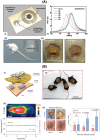Biosensors integrated within wearable devices for monitoring chronic wound status
- PMID: 39926013
- PMCID: PMC11803754
- DOI: 10.1063/5.0220516
Biosensors integrated within wearable devices for monitoring chronic wound status
Abstract
Slowly healing wounds significantly affect the life quality of patients in different ways, due to constant pain, unpleasant odor, reduced mobility up to social isolation, and personal frustration. While remote wound management has become more widely accepted since the COVID-19 pandemic, delayed treatment remains frequent and results in several wound healing related complications. As inappropriate management of notably diabetic foot ulcers is linked to a high risk of amputation, effective management of wounds in a patient-centered manner remains important to be implemented. The integration of diagnostic devices into wound bandages is under way, owing to advancements in materials science and nanofabrication strategies as well as innovation in communication technologies together with machine learning and data-driven assessment tools. Leveraging advanced analytical approaches around local pH, temperature, pressure, and wound biomarker sensing is expected to facilitate adequate wound treatment. The state-of-the-art of time-resolved monitoring of the wound status by quantifying key physiological parameters as well as wound biomarkers' concentration is presented herewith. A special focus will be given to smart bandages with on-demand delivery capabilities for improved wound management.
© 2025 Author(s).
Conflict of interest statement
The authors have no conflicts to disclose.
Figures






Similar articles
-
Poorly designed research does not help clarify the role of hyperbaric oxygen in the treatment of chronic diabetic foot ulcers.Diving Hyperb Med. 2016 Sep;46(3):133-134. Diving Hyperb Med. 2016. PMID: 27723012
-
Recent advances in biosensors for real time monitoring of pH, temperature, and oxygen in chronic wounds.Mater Today Bio. 2023 Aug 19;22:100764. doi: 10.1016/j.mtbio.2023.100764. eCollection 2023 Oct. Mater Today Bio. 2023. PMID: 37674780 Free PMC article. Review.
-
Advanced Dressings for Chronic Wound Management.ACS Appl Bio Mater. 2024 May 20;7(5):2660-2676. doi: 10.1021/acsabm.4c00138. Epub 2024 May 9. ACS Appl Bio Mater. 2024. PMID: 38723276 Review.
-
Systematic reviews of wound care management: (3) antimicrobial agents for chronic wounds; (4) diabetic foot ulceration.Health Technol Assess. 2000;4(21):1-237. Health Technol Assess. 2000. PMID: 11074391 Review.
-
A Review of Recent Advances in Flexible Wearable Sensors for Wound Detection Based on Optical and Electrical Sensing.Biosensors (Basel). 2021 Dec 23;12(1):10. doi: 10.3390/bios12010010. Biosensors (Basel). 2021. PMID: 35049637 Free PMC article. Review.
References
-
- Ellis S., Patel M., Koshchak E., and Lantis II J., “ Location of lower-extremity diabetic foot ulcers with concomitant arterial or venous disease,” Wounds International 11, 20–23 (2020).
LinkOut - more resources
Full Text Sources
Research Materials

